ISSN ONLINE(2320-9801) PRINT (2320-9798)
ISSN ONLINE(2320-9801) PRINT (2320-9798)
Shweta Warade, Rajesh Patil
|
| Related article at Pubmed, Scholar Google |
Visit for more related articles at International Journal of Innovative Research in Computer and Communication Engineering
Fingerprint biometrics provides identity verification with a strong degree of confidence over past few decades. Present work focuses on special branch of fingerprint recognition namely, touch-less fingerprint recognition which has fundamental advantage in terms of better hygiene, safety and latent fingerprints over traditional touch-based systems. Such systems find applications in numerous fields such as secure access to laptops and computer systems, cellular phones, banking, ATMs etc. Although lot of work have been done on touch-less fingerprint recognition systems, still people are looking for more accuracy. The proposed touch-less fingerprint recognition system opt digital camera as the device to acquire the fingerprint image and it consists of three main steps: Pre-processing, Feature extraction and Verification. Current work presents a comparative performance evaluation of two widely used classifiers: Support Vector Machine (SVM) and Gaussian Mixture Model (GMM). Experimental results illustrates that GMM shows slightly better accuracy than SVM.
KEYWORDS |
| Touch-less fingerprints, Minutiae features, Support Vector Machine (SVM), Gaussian Mixture Model (GMM). |
I. INTRODUCTION |
| At present there are number of various biometric systems are available in the market and more progressively getting used for almost everything that require security or identification and authentication. The quality of biometrics depends on accuracy, user recognition, cost and execution time and level of safety required [1]. As compared to other identification techniques, Fingerprint verification is simple, faster, inexpensive and reliable to recognize the individuals. It is a most established technique and has largest market share for authentication purpose [2]. A fingerprint is the pattern of ridges and valleys on the shell of a fingertip, and the structure of which is determined in the first seven months of fetal growth [3]. Current fingerprint recognition system requires that the users touch the device that is sensor for biometric acquisitions [4]. Touch-less fingerprint recognition system is proposed to overcome problems which are occurred in touch-based systems like skin distortion, contamination and fingerprint residue. Both touch-based as well as touch-less fingerprint recognition system follows same steps: pre-processing, fingerprint feature extraction and verification [4]. |
II. RELATED WORK |
| There are several techniques in the literature based on uninhibited acquisition and inhibited acquisition setups. Uninhibited acquisition setups include mobile devices, laptops etc which requires less accuracy. Inhibited acquisition setups are used in order to get more accuracy e.g. banking services [4]. In both these setups, one or more images are captured by digital camera in touch-less recognition system, and then touch equivalent fingerprint images can be computed by performing pre-processing. After the computation of finger images, enhancement can be done to get ridge pattern. For other stages like feature extraction and matching, same methods are employed same as in touch-based recognition systems [3][6]. Feature extraction can be done by using Gabor filter or by minutiae detection [5][11][12]. Matching can be done by using different classifiers like support vector machine (SVM), principal component analysis (PCA), Euclidean distance method [5][6][9][11]. |
III. TOUCH-LESS FINGERPRINT |
| A Touch-less fingerprint recognition system does not require any contact between a sensor and a finger. Thus, the finger‘s minutiae and ridge information cannot be changed or distorted as it will be free of skin deformation. |
| Table 1 shows the comparison of Touch-less and Touch-based fingerprint recognition system. Also, Touch-less fingerprint recognition system can capture fingerprint images consistently because it is not affected by different skin conditions or latent fingerprints. Touch-less sensing scheme can be implemented using a single camera. Touch-less fingerprint recognition system is free from the troubles in terms of maintenance, hygienic, latent fingerprints and so forth [5]. Some taxing problems may occur while developing the touch-less system. These problems are non-uniform lighting, low contrast between the ridge and the valley pattern on fingerprint image, motion blurriness and defocus. Hence Fingerprint image pre-processing step is important to overcome these problems. |
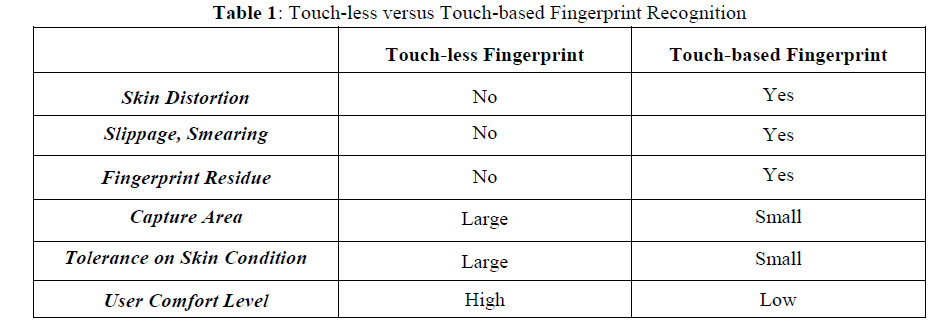 |
IV. SUPPORT VECTOR MACHINE (SVM) |
| SVM is a binary classifier that makes its decisions by constructing a linear decision margin or hyper-plane that optimally separates two classes [5][6][7]. A separating hyper-plane is a linear function that is capable of separating the training data without error. Assume that the training data consisting of n samples (a1, b1). . . (an, bn), a ∈ d, b ∈ +1,−1 can be separated by the hyper-plane decision function, |
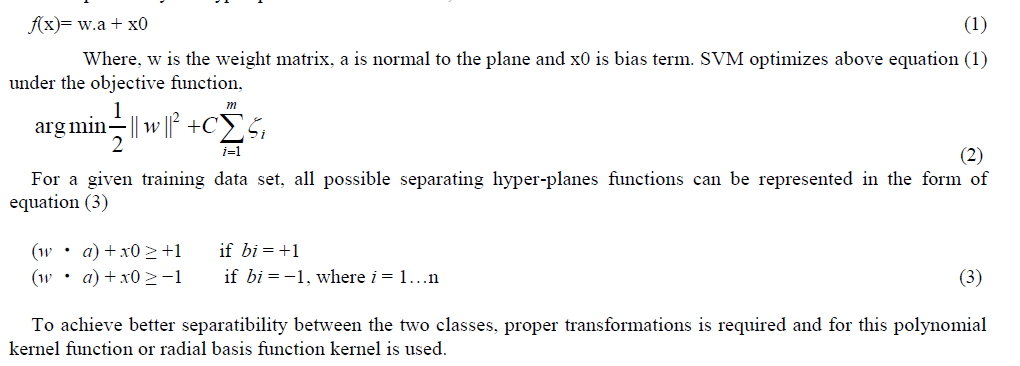 |
V. GAUSSIAN MIXTURE MODEL (GMM) |
| The GMM is a soft decision classifier where each class has a Gaussian distribution [7][8]. GMM assumes the parametric form for probability distribution as [8], |
 |
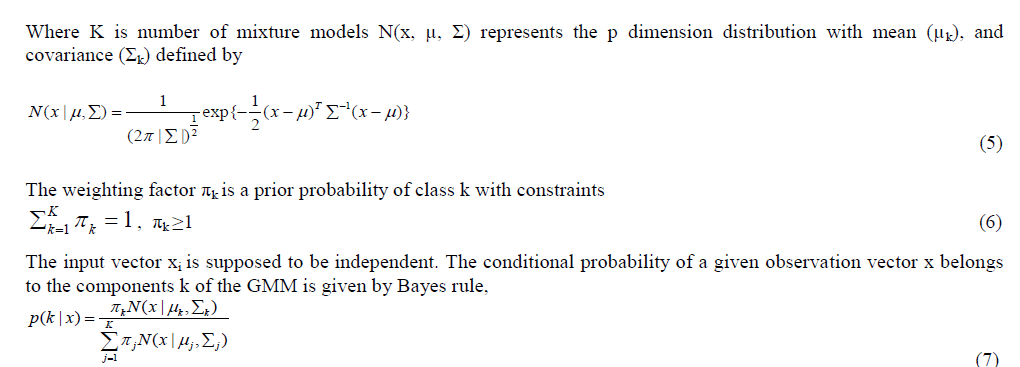 |
| By using Expectation maximization (EM) algorithm, parameters π, μ and Σ can be estimated. This finds the parameters of GMM that gives maximum likelihood of observed data X. EM algorithm involves two steps [8]. In the expectation step, the probability that each data object is drawn from each of the k distributions is calculated according to the estimated parameters for k distributions previously (randomly chosen initially). In the maximization step, the probabilities from the expectation step are used to derive new estimates for the parameters of the k distributions such that the value of the log likelihood function is increased. The process continues until the log likelihood function has reached its maximum value. |
VI. PROPOSED TOUCH-LESS FINGERPRINT RECOGNITION ALGORITHM |
| The touch-less fingerprint recognition system can be divided into three main steps. Each block performs a unique function over the input image. The three main steps of Touch less Fingerprint Recognition System are: Pre-processing, Feature Extraction and verification or Matching. We consider minutiae features as the correspondences for initial alignment. It is explained in the rest of the paper. Figure 1 shows the block diagram of proposed Touch-less Fingerprint Recognition System. |
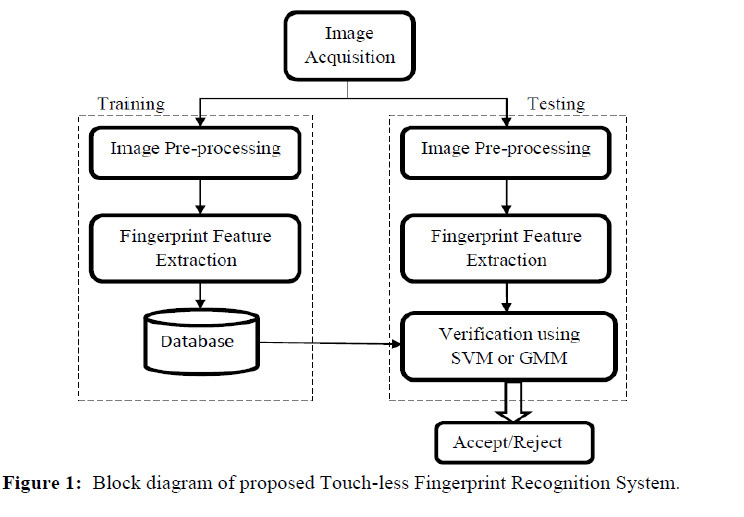 |
| A. Pre-processing: |
| In touch-less fingerprint recognition system, acquired fingerprint images may have problems like non uniform lightning, low contrast between ridges and valleys, noise etc. Such problems can be removed by pre-processing and it is an important step for detecting minutiae from the fingerprints. The purpose of fingerprint pre-processing step is to make fingerprint images standard and ready for feature extraction. Pre-processing is an important step prior to feature extraction and verification. Pre-processing is classified into Normalization, Image Segmentation, and Image Enhancement. |
| 1. Normalization: |
 |
| 2. Image Segmentation: |
| Segmentation of fingerprint image is essential so as to reduce the size of the input data, to remove undesired background [9], and to focus on area which is in favor of the central part of the fingerprint. Here color based segmentation technique is used for segmentation. Various color spaces are available to detect the skin color but simplest is RGB. Hence we are using RGB color space for skin segmentation. Skin color based segmentation technique has some advantages over other techniques like color processing is much faster and robust in nature. |
| RGB is widely used in skin detection literature because of its simplicity [10]. The RGB color model is a preservative color model in which to reproduce a wide array of colors red, green, and blue light are added together in various ways. Here we extract all the three components R, G and B. If the extracted R, G, B values of a pixel satisfied the equation (9), consider it as a skin otherwise non-skin [10]. |
| s = R + G + B; |
| (R >= G && (G >= (B+4)) && s>=16 && s<=750) |
| 3. Image Enhancement: |
| Fingerprint image quality is a key factor in the performance of minutiae extraction and matching algorithm. The purpose of an enhancement algorithm is to improve the contrast of the ridge structures in a fingerprint. Consider enhancement of fingerprint image using STFT analysis, as established Fourier analysis is not adequate to analyze the image entirely because of non-stationary nature of image [5] [9]. Here the image is first divided into overlapping windows to preserve the ridge stability and removes âÂÂblock‘ effects common with other block processing image operations [4]. Then the image is assumed stationary inside this small window. The Fourier spectrum in polar form is represented as F( r,ô ). After the Fourier spectrum of this small region is analyzed, then Probabilistic estimatation of the ridge orientation, ridge frequency, and energy map are obtained. A probability density function p( r,ô ) |
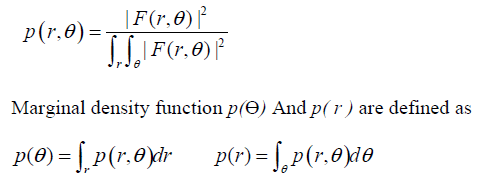 |
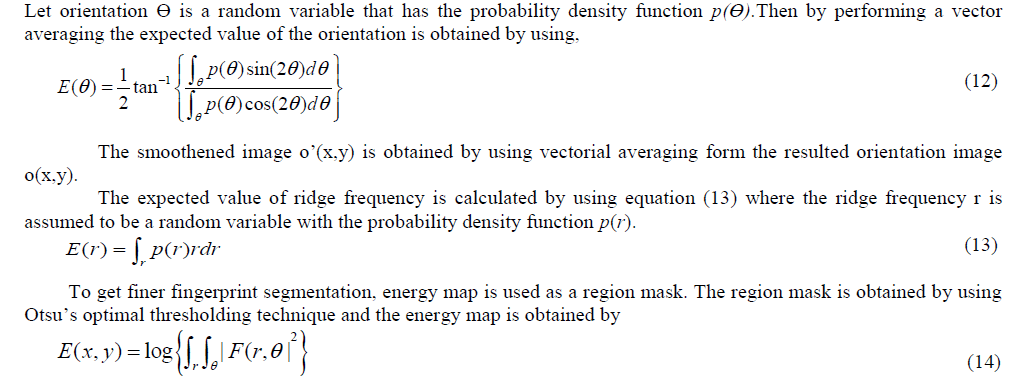 |
| B. Feature Extraction |
| Most fingerprint recognition methods make the use of minutiae as the fingerprint features [11][12]. Minutiae extraction involves the steps: binarization smoothing, local ridge orientation estimation, thinning and minutiae detection. Most minutiae extraction algorithms work on binary images: the black pixels that represent ridges, and the white pixels that represent valleys. It improves the contrast between the ridges and valleys in a fingerprint image, and therefore facilitates the extraction of minutiae. The orientation field of a fingerprint image defines the local orientation of the ridges enclosed in the fingerprint. For orientation field, we used block size of 7×7. The local orientation at pixel (i, j) can be estimated by computing the gradients ∂x(i, j) and ∂y(i, j) for each pixel in the block, which are the gradient magnitudes in the x and y directions, respectively and gradient operator is estimated as Sobel operator. |
| For smoothing, Gaussian smoothing is performed by using Gaussian filter of a size 5×5. Width of ridges of Black and white image consists of more than a pixel, this prevents from extracting the minutiae points and thus ridges are to be thinned. Along with thinning, it is necessary to remove H-breaks (unnecessary noise bridges that connect two or more ridges) and spikes (noisy projection out of some ridges) in the image. Minutiae points are exclusive recognition points, which are ridge endings (points where the ridge curve terminates) and bifurcations (a ridge splits from a single path to two paths). Minutiae extraction is done by using a 3×3 sliding window to observe the local region of each ridge pixel in the image. A pixel is considered as a ridge ending if it has single neighbouring ridge pixel in the window, and considered as a bifurcation if it has three neighbouring ridge pixels |
VII. RESULTS AND DISCUSSION |
| All the finger-print images are captured by using a low cost digital camera with 8 mega-pixels of effective resolutions and focus range is 4cm to 7cm. Experiments are conducted over 110 samples. Each sample is processed with all steps using MATLAB (R2012a) image processing toolbox. Verification accuracy is tested by using SVM and GMM classifier. For SVM, we found 86 samples correctly matched out of 110 while for GMM number of correctly matched finger-print images are 98. Therefore we can say that GMM shows 89.09% accuracy while SVM 78.19% accuracy over a database containing 110 fingerprint samples. The following Table 2 shows the accuracy of both the classifiers at different number of fingerprint sample images. |
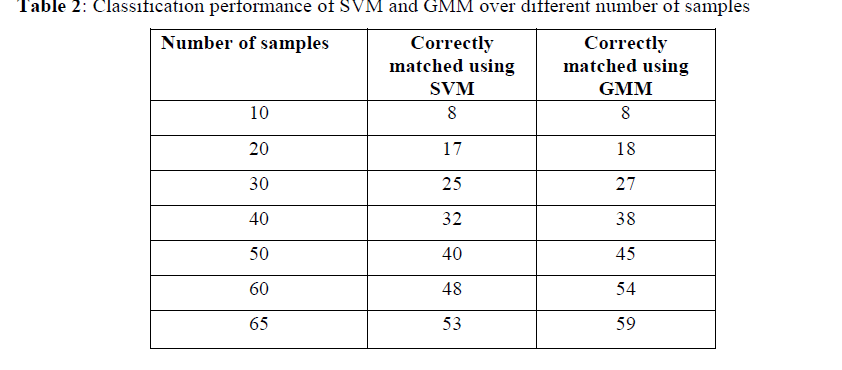 |
| The classification performance of SVM and GMM over different number of samples is represented in the following Figure 2. In this figure, the X-axis represents the number of samples used for each of the experiment and the Y-axis showcases the accuracy found for respective experiments. The accuracy is the number of correctly matched fingerprints samples from the each respective sample database. From the graph, it‘s quite evident that as the number of samples increase, the accuracy for the GMM classifier becomes slightly better as compared to the SVM classifier. |
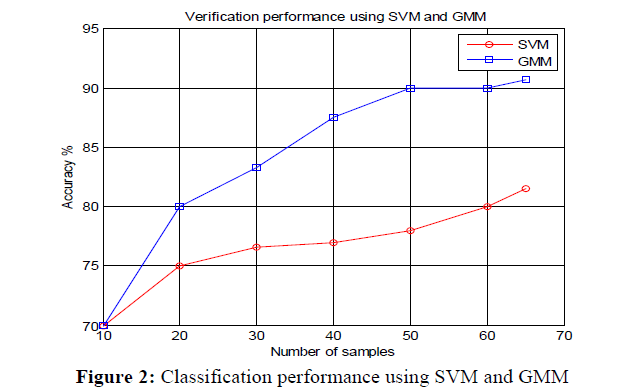 |
VIII. CONCLUSION AND FUTURE WORK |
| Touch-less fingerprint recognition have been a recent interest of many researchers. A secure digital camera based touch-less finger-print verification system is proposed. In this work, we concentrated on pre-processing; minutiae feature extraction and classification performance using SVM and GMM. Experiments shows that GMM contributes slightly better recognition performance than SVM. All the laptops, ATM centres, mobiles etc devices have a camera. So, one of the main applications which can be implemented in future will be installation of such recognition system in these devices. Accuracy needs to be checked on larger database which is a basic requirement for any fingerprint recognition system. |
References |
|